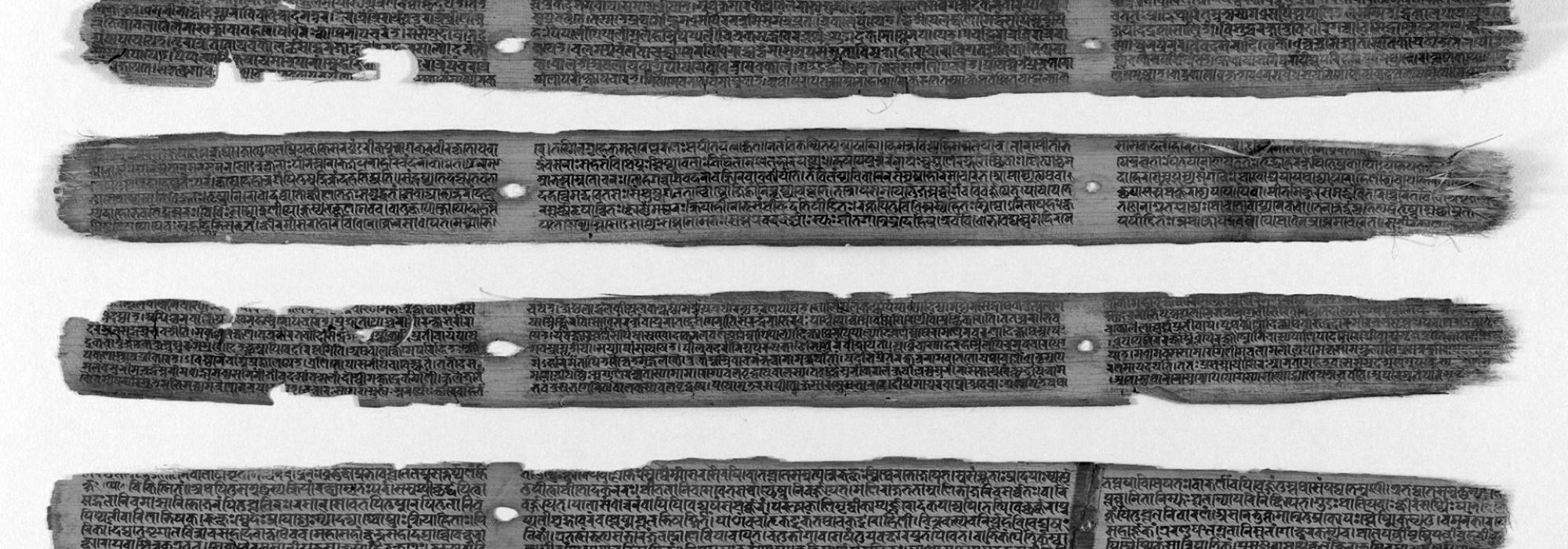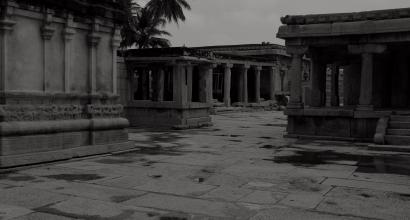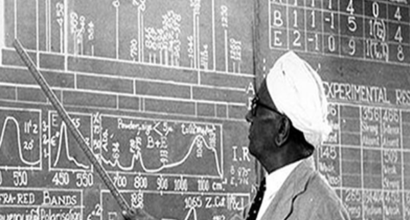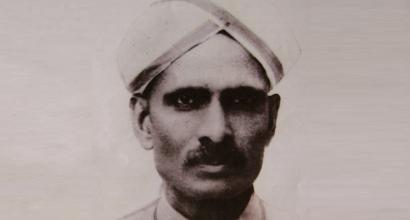Whenever I recall the name of S G Narasimhacharya, I’m also reminded of Mandayam Aji Ramanuja Iyengar. SGN (S G Narasimhacharya), RN (R Narasimhacharya), and MAR (M A Ramanuja Iyengar) – these three were a group. The three of them were relatives and they all worked passionately in the area of classical Kannada literature.
Ramanuja Iyengar (1864–1937) served as a teacher in the Wesleyan Mission School, Mysore for a long time. For a short while he also worked in the Government’s Department of Education. Among his notable works is the publication of the Karṇāṭaka Kāvyamañjarī.
Exploration of Literary Works
During his hours of leisure, Ramanuja Iyengar visited libraries that contained literary works in haḻagannaḍa (classical Kannada), gather treatises written on palm leaf manuscripts, study them, and finally prepare the same for publication.
Only someone with experience in this domain can truly understand how tedious and frustrating it is to undertake this task. Old manuscripts written on palm leaves are quite similar to dry wood. They are so fragile that a mere touch can crumble them. They must be separated from one another with extreme care. Then comes the task of reading the manuscript. A special concoction made of leaves should first be applied on the palm leaf. That darkens the letters, making it more readable. The next big difficulty is to untie—i.e. decipher—the chain-like Moḍi script (ancient script written in a cursive style). Today’s people cannot understand it. Further, poetic verses aren’t divided into lines on palm leaf manuscripts. Even the verses themselves will not be separate from one another.[1]
An entire treatise would be a chain of letters and appear like a single sentence from beginning to end. If it takes half a day to decipher the meaning of a single side of a palm leaf manuscript, it would hardly be a surprise.
Ramanuja Iyengar was a person who accomplished this strenuous endeavour. Mere erudition is not sufficient for this task. Along with that, an incredible amount of enthusiasm, patience, and forbearance is required. It is my opinion that the preparation of a draft for print from manuscripts is far more difficult than writing a new work.
What was more difficult than preparing these works was perhaps financing their publication. Those who are aware of the amount of encouragement given to Kannada poetry in today’s unified Karṇāṭaka can easily guess how much encouragement was given to the same by the people sixty years ago.[2] During such a period, for M A Ramanuja Iyengar to run the Karṇāṭaka Kāvyamañjarī without losing enthusiasm for such a long time is indeed an act of great sacrifice; when we think about it, we are truly astonished.
If the material losses and fruitless exhaustions weren’t enough, Ramanuja Iyengar took up another such burden. That was the publication of Karṇāṭaka Kāvyakalānidhi, which published old literary works along with new ones. Karṇāṭaka Kāvyakalānidhi was a series in which seventy to seventy-five books were published. In this great endeavour, Ramanuja Iyengar toiled indefatigably. But he didn’t care much for his physical strain or monetary losses. Many haḻagannaḍa (classical Kannada) and naḍugannaḍa (middle Kannada, pre-modern Kannada) works were published as part of the series. Initially they were published in parts and later they as individual books along with an introduction about the poet and related study materials. Kāvyas (poetical works) like Gadhāyuddha of Ranna, Mallināthapurāṇa of Nāgacandra, Nemicandra’s Līlāvati, Harihara’s Girijākalyāṇa, Yashodharacarita of Janna, Kabbigara Kāva of Anḍayya, and Cauṇḍarāya’s Abhinavadaśakumāracarite; śaṭpadi (poems with six-line verses) works such as Rāghavāṅka’s Hariścandrakāvya, Kanakadāsa’s Naḻacarite, and Rāmapaṭṭābhiṣeka of Mahālakṣmi; and prose works such as Muddaṇa’s Rāmāśvamedha were published in Kāvyakalānidhi series. Further, Ramanuja Iyengar also published treatises on lakṣaṇa (characteristics of poetry) such as Udayādityālaṅkāra, Nāgavarma’s Chandombudhi; lexical treatises such as Śabdasāra Nighaṇṭu and Caturāsya Nighaṇṭu; and a treatise on alaṅkāra-śāstra (poetics) – Apratimavīracarita. An advaita work titled Vedāntavivekasāra and a viśiṣṭādvaita work titled Cikkadevarāyabinnapam were also published in the same series.
Ramanujayyangarya’s own works such as Prabandhamañjarī; Kavisamayam, an aesthetic criticism; and numerous prose translations of plays were included in the Karṇāṭaka Kāvyakalānidhi series.
Bhabha’s Encouragement
During those days, the officers of the Department of Education were perceptive in identifying the good qualities of others and were endowed with benevolence. Hormasji Jehangir Bhabha was their head.[3]
I feel compelled to write lofty words about Bhabha, erring on the side of exaggeration. He had earned his M.A. degree at a young age of eighteen and was considered a great scholar. He was from a Parsi family and was a close relative to the world famous Jamshedji Tata. The honour of bringing him to Mysore goes to Sir K Sheshadri Iyer. Bhabha worked as lecturer and president of the Maharaja’s College, Mysore. When he was made the head of the Department of Education, he travelled the length and breadth of the province and also learned to communicate in Kannada. His travel around the region was largely on a bicycle. His bicycle was one among the earliest bicycles that came to India.
Once he had visited Mulabagal. I was a student when he was inspecting our school. I remember an incident from that time. Oriental Reader was the name of our textbook. In that, we had a lesson about a lion. When Bhabha opened the book, he saw that page. He asked me to read it out aloud. There I found the English word ‘majesty’. He asked for its Kannada equivalent. If I remember right, it was either I, or the one sitting next to me, who said, “Gambhīra.” Turning towards the headmaster, he said, “What about vaikhari – will that work?” Chandrashekhara Shastri replied, “But that word also has a specific linguistic implication.” Bhabha said, “Yes, yes. But while teaching, children must be told the meanings in practice.” This shows the hands on acquaintance he had in Kannada language.
There’s another incident I wish to narrate. I learnt this from a reliable source. There was a Sanskrit school in a small village in Kolar district; it was sustained by a government grant. The then inspector, having examined the school, recommended that the grant be cancelled since the school wasn’t running satisfactorily. While sending this to the government Bhabha wrote some comments about the decision; it was his recommendation that the grant should not be cancelled. Those comments are interesting and are as follows:
1. The inspector has complained that the school doesn’t follow proper timings. But the government hasn’t provided the school with a clock and therefore the villagers are following their preferred timings.
2. There is a complaint that there is an assembly of villagers in the school who aren’t students. Let them be there. It is definitely a benefit for them—and not a loss—if they listen to a word or two of Sanskrit. Even this paves the way for promoting education.
3. It is also mentioned that Shastri’s teaching lasts till two in the afternoon. Isn’t that a good thing? He’s a Vedic brāhmaṇa and is bound to perform daily rituals. When the rituals demand more work from him, he might cut short the class and at other times, he might elongate the duration of teaching, thus compensating for what he missed out.
4. If the government wishes to promote education in the country it should be a little lenient towards Vedic brāhmaṇas. We have to primarily ask these questions: Are they training the students properly? Are the villagers respecting the work they do? Since the answers for both these questions are satisfactory in the case of this school, the grants should not be stopped.
Somewhere during 1930, H J Bhabha visited Bangalore for some reason, perhaps in relation to his work at the Tata Institute. He stayed in the West End hotel. By some means, Prof. Bellave Venkatanaranappa came to know about this and was enthusiastic to hear the news. That was the time the Karṇāṭaka Saṅgha of Central College, Bangalore was involved in the publication of a book. Venkatanaranappa was the president of the Karṇāṭaka Saṅgha. Venkatanaranappa wished to give the first copy of the book to Bhabha. It’s quite natural that the others seconded his decision. Venkatanaranappa, T S Venkannaiah, Cha Vasudevaiah, and I went to the West End. It is there I witnessed the sort of admiration that Bhabha had towards Vasudevaiah. Venkatanaranappa placed the book in Bhabha’s hands. He opened the book, read it here and there, and expressed his appreciation. He congratulated the work undertaken by the Karṇāṭaka Saṅgha.
Bhabha’s respect towards Kannada was really of a superior order.
It’s natural that Bhabha was sympathetic towards the literary efforts of M A Ramanuja Iyengar. It is only due to Bhabha’s encouragement that he could publish periodicals like the Kāvyamañjarī and Kāvyakalānidhi for some time.
When I met Ramanuja Iyengar for the first time, he was quite aged. He was at Melukote to pay his respects to the presiding deity, Śrī Tirunārāyaṇasvāmi. After I introduced myself, we had a friendly conversation.
I have read through two of his original works – Kavisamayam and Prabandhamañjarī. Both these works reflect his deep knowledge of poetry, his command over the language, and his erudition in the subject. In the intellectual world of Karnataka, if readers were endowed with the ability to discern the quality of great works, his books would have seen several reprints.
Alagingaracharya
Another Kannada litterateur who belongs in the same league is Devaśikhāmaṇi Alasingaracharya. A book of poems written by him, titled Celuvanārāyaṇaśatakam is close to my heart. It has a great literary style. Fascinated by his poem, I longed to meet him. I tried many times to meet him face to face. But I finally got the opportunity during my second or third visit to Melukote. By that time, Acharya was really old and weak. When I went there, he was offering the Tuḻasi Arcana in the temple by himself.
By nature, Acharya was courteous and modest. In thought, in speech, and in actions, he was a Sadvaiṣṇava (a well-natured devotee of Viṣṇu). Devotion towards the Supreme, love and respect towards learning, and adoration of good literature – these were qualities that one could easily recognize in his actions.
Acharya’s translations of Svapnavāsavadatta and Pañcarātra reflect his poetic connoisseurship.
At one point, he was a teacher in Mysore. Later after moving to Madras, he taught in Madras Christian College. It is during this period that he was able to do a great service to Kannada literature and Kannadigas. He translated the three great jewels of the treasury of Sanskrit literature into Kannada – Śrīmadrāmāyaṇam, Śrīmanmahābhārata, and Śrīmadbhāgavata. His translations are authoritative. His literary style is at once acceptable to scholars and attuned to the majesty of the subject matter. At a time when Kannada prose translations of Rāmāyaṇa, Mahābhārata, and Bhāgavata were unavailable to the people, Alasingaracharya’s translations came as a treasure to them.
This is an English translation of the eighth chapter of D V Gundappa’s Jnapakachitrashaale – Vol. 3 – Sahityopasakaru. Thanks to Śatāvadhāni Dr. R Ganesh and Sudarshan Muralidhara for their review. Edited by Hari Ravikumar.
Footnotes
[1] Translator’s Note: Typically in palm leaf manuscripts, the text is continuous; there is nothing to distinguish the end of a line or a verse. Both at the level of form and content, deciphering a manuscript is a difficult task.
[2] Translator’s Note: In other words, there was hardly any encouragement for such activities.
[3] Hormasji Jehangir Bhabha was an Assistant Professor in Elphinstone College, Bombay when he was invited to be the Vice-Principal of Central College in 1876. In 1884, Bhabha became the Principal of the college. During the period 1890-1909 Bhabha was the Education Secretary to the Mysore Government.




































